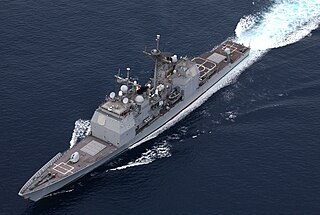Automatic Link Establishment, commonly known as ALE, is the worldwide de facto standard for digitally initiating and sustaining HF radio communications. ALE is a feature in an HF communications radio transceiver system that enables the radio station to make contact, or initiate a circuit, between itself and another HF radio station or network of stations. The purpose is to provide a reliable rapid method of calling and connecting during constantly changing HF ionospheric propagation, reception interference, and shared spectrum use of busy or congested HF channels.

Interoperability is a characteristic of a product or system to work with other products or systems. While the term was initially defined for information technology or systems engineering services to allow for information exchange, a broader definition takes into account social, political, and organizational factors that impact system-to-system performance.

The Defense Information Systems Agency (DISA), known as the Defense Communications Agency (DCA) until 1991, is a United States Department of Defense (DoD) combat support agency composed of military, federal civilians, and contractors. DISA provides information technology (IT) and communications support to the President, Vice President, Secretary of Defense, the military services, the combatant commands, and any individual or system contributing to the defense of the United States.

Software-defined radio (SDR) is a radio communication system where components that conventionally have been implemented in analog hardware are instead implemented by means of software on a personal computer or embedded system. While the concept of SDR is not new, the rapidly evolving capabilities of digital electronics render practical many processes which were once only theoretically possible.

The Joint Tactical Information Distribution System (JTIDS) is an L band Distributed Time Division Multiple Access (DTDMA) network radio system used by the United States armed forces and their allies to support data communications needs, principally in the air and missile defense community. It produces a spread spectrum signal using Frequency-shift keying (FSK) and Phase-shift keying (PSK) to spread the radiated power over a wider spectrum (range of frequencies) than normal radio transmissions. This reduces susceptibility to noise, jamming, and interception. In JTIDS Time Division Multiple Access (TDMA) (similar to cell phone technology), each time interval (e.g., 1 second) is divided into time slots (e.g. 128 per second). Together, all 1536 time slots in a 12-second interval are called a "frame". Each time slot is "bursted" (transmitted) at several different carrier frequencies sequentially. Within each slot, the phase angle of the transmission burst is varied to provide PSK. Each type of data to be transmitted is assigned a slot or block of slots (channel) to manage information exchanges among user participation groups. In traditional TDMA, the slot frequencies remain fixed from second to second (frame to frame). In JTIDS TDMA, the slot frequencies and/or slot assignments for each channel do not remain fixed from frame to frame but are varied in a pseudo-random manner. The slot assignments, frequencies, and information are all encrypted to provide computer-to-computer connectivity in support of every type of military platform to include Air Force fighters and Navy submarines.
In NATO, a standardization agreement defines processes, procedures, terms, and conditions for common military or technical procedures or equipment between the member countries of the alliance. Each NATO state ratifies a STANAG and implements it within its own military. The purpose is to provide common operational and administrative procedures and logistics, so one member nation's military may use the stores and support of another member's military. STANAGs also form the basis for technical interoperability between a wide variety of communication and information systems (CIS) essential for NATO and Allied operations. The Allied Data Publication 34 (ADatP-34) NATO Interoperability Standards and Profiles which is covered by STANAG 5524, maintains a catalogue of relevant information and communication technology standards.

The Aegis Combat System is an American integrated naval weapons system, which uses computers and radars to track and guide weapons to destroy enemy targets. It was developed by the Missile and Surface Radar Division of RCA, and it is now produced by Lockheed Martin.

Missile defense is a system, weapon, or technology involved in the detection, tracking, interception, and also the destruction of attacking missiles. Conceived as a defense against nuclear-armed intercontinental ballistic missiles (ICBMs), its application has broadened to include shorter-ranged non-nuclear tactical and theater missiles.

The Joint Tactical Radio System (JTRS) aimed to replace existing radios in the American military with a single set of software-defined radios that could have new frequencies and modes (“waveforms”) added via upload, instead of requiring multiple radio types in ground vehicles, and using circuit board swaps in order to upgrade. JTRS has seen cost overruns and full program restructurings, along with cancellation of some parts of the program. JTRS is widely seen as one of the DoD's greatest acquisition failures, having spent $6B over 15 years without delivering a radio.
Link 16 is a military tactical data link network used by NATO members and other nations, as allowed by the MIDS International Program Office (IPO). Its specification is part of the family of Tactical Data Links.
Network-centric warfare, also called network-centric operations or net-centric warfare, is a military doctrine or theory of war that aims to translate an information advantage, enabled partly by information technology, into a competitive advantage through the computer networking of dispersed forces. It was pioneered by the United States Department of Defense in the 1990s.
TADIL-A/Link 11 is a secure half-duplex tactical data link used by NATO to exchange digital data. It was originally developed by a joint committee including members from the Royal Canadian Navy, US Navy and Royal Navy to pass accurate targeting information between ships. The final standard was signed in Ottawa in November 1957, where the British proposed the name "TIDE" for "Tactical International Data Exchange". It was later made part of the NATO STANAG standardization process.
Bowman is the name of the tactical communications system used by the British Armed Forces.
Medical Communications for Combat Casualty Care (MC4) is a deployable health support information management system of the U.S. Army.

The Operational Test and Evaluation Force (OPTEVFOR) is an independent and objective agency within the United States Navy for the operational testing and evaluation (OT&E) of naval aviation, surface warfare, submarine warfare, C4I, cryptologic, and space systems in support Navy and Department of Defense acquisition programs.

Multifunctional Information Distribution System (MIDS) is the NATO name for the communication component of Link-16.
The Joint Theater Level Simulation (JTLS) is used to simulate joint, combined, and coalition civil-military operations at the operational level. Used for civil/military simulations and humanitarian assistance/disaster relief (HA/DR) scenarios, JTLS is an interactive, computer-assisted simulation that models multi-sided air, ground, and naval resources with logistical Special Operation Forces (SOF) and intelligence support. The primary purpose of JTLS is to create a realistic environment in which agency staff can operate as they would within a real-world or operational situation. A training audience conducts a scenario or event to practice their ability to coordinate various staff functions.
Cooperative Engagement Capability (CEC) is a sensor network with integrated fire control capability that is intended to significantly improve battle force air and missile defense capabilities by combining data from multiple battle force air search sensors on CEC-equipped units into a single, real-time, composite track picture. This will greatly enhance fleet air defense by making jamming more difficult and allocating defensive missiles on a battle group basis.

The Defense Acquisition Program Administration was founded on January 1, 2006 as part of a comprehensive reform of the defense acquisition project, including the introduction and development of military equipments, and is a central administrative agency of the South Korean Ministry of National Defense. The DAPA has exclusive authority to plan and budget defense development and procurement programs for the ROK Armed Forces and to enact Korean Defense Specifications (KDS). Sub-agencies of DAPA include the Agency for Defense Development (ADD) responsible for defense development and Defense Agency for Technology and Quality (DTaQ) responsible for defense improvement programs and defense quality certification tests.

Federated Mission Networking (FMN) is a significant initiative to help ensure interoperability and operational effectiveness of the North Atlantic Treaty Organization, it is a key contribution to the Connected Forces Initiative, helping Allied and Partner forces to better communicate, train and operate together. This includes the NATO Command Structure as well as the NATO Force Structure. The purpose of FMN is ultimately to support Command, Control, Communications, Computers, Intelligence, Surveillance and Reconnaissance (C4ISR) and decision-making in operations by enabling a rapid instantiation of mission networks. Including the NATO Command Structure, 37 nations have joined the FMN initiative as so called "FMN Affiliates" and work together under the FMN Framework Process to coordinate the design, development and delivery of operational and technical capabilities required to conduct net-centric operations. Each development increment is referred to as an "FMN Spiral". The respective requirements, architecture, standards, procedural and technical instructions are documented in so called "FMN Spiral Specifications". FMN Spiral Specifications are based on well known standards and best practices, hence supported by most off-the-shelf products and vendor neutral. TACOMS standards and profiles specify a common, technology and topology independent network interoperability layer for federated mission networks. There is also a rolling 10-year FMN Spiral Specification Roadmap of the envisioned future capabilities. At the same time, the Coalition Interoperability Assurance and Validation (CIAV) process ensures that current interoperability issues are being identified and fed back into FMN capability development.










